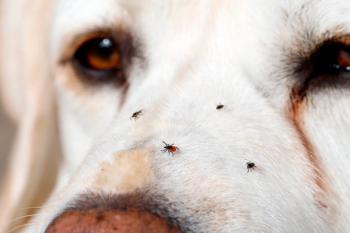
Seamless solutions for difficult parasite prevention scenarios
Sew up parasite prevention gaps with these tailored tips to target a range of veterinary clients.
Photo: Shutterstock/Irina oxilixo DanilovaAlthough your practice may have a perfectly patterned parasite prevention protocol that works for most patients, sometimes you need to make alterations in the form of individual recommendations. You may have a compliant client who needs alternative ways to control parasites, or maybe you have a noncompliant client who needs easy-to-follow options. Sometimes even a pet's environment and lifestyle can dictate the need for a personalized plan.
As a member of the veterinary team, you must be able to educate clients with confidence. Be sure you are familiar with the products available in your practice. Talk to the veterinarians in your practice so that you fully understand their recommendations for unique situations. You may even suggest a meeting so the whole team is on the same page when it comes to parasite control.
When the time comes to talk to clients about individualized parasite prevention, you will need to be clear, concise and supportive. Here are some tips to help with these client conversations.
Scenario one: The compliant client
A compliant client takes the veterinarian's recommendations to heart. She refills preventive products regularly and does her best to follow instructions. She asks questions when she is confused or concerned about something. With the compliant client, you mainly need to explain what the veterinarian recommends and why.
The scenario: Ms. Morgan brings in her Golden retriever, Murray, for an exam to have his skin checked because he's been itchy. The vet finds evidence of fleas, but his skin is otherwise fine. The veterinarian recommends some anti-pruritic shampoo and asks you to discuss alternative flea preventions with the client. When you go in to discuss the products, Ms. Morgan seems confused.
Ms. Morgan: “I've been using the parasite prevention you gave us. Why does he still have fleas?”
You: “This is not your fault, Ms. Morgan. Let's explore other products that may work better for Murray. In addition, we will review how you can minimize the fleas in the environment. We will do whatever we can to help you and Murray.”
Scenario two: The noncompliant client
A noncompliant client often has a harder time following recommendations. She may have a busy life and forget to administer preventive products. She may even decline to purchase products for various reasons. This client may do research through outside sources (ahem, Dr. Google) and make her own decisions about preventive care. It's important not to be pushy or judgmental-instead, try to see this client's point of view. Clearly state facts to this client and allow her to make her own decision. Warn her of possible risks, but do so without criticism.
The scenario: Juniper, a Russian blue cat, is in the office for her annual exam (which is overdue). Mrs. Johnson thinks everything is going well with Juniper. In addition, the fecal exam comes back positive for hookworms. She has no evidence of fleas on her exam. The veterinarian prescribes a broad-spectrum dewormer and asks you to discuss parasites and prevention. Mrs. Johnson is surprised.
Mrs. Johnson: “She's a really healthy cat. I didn't think she needed anything special. I got that product from you guys at our last visit, but I'm not sure how often I used it. She really didn't like it so I skipped it sometimes. I think we have some more at home. Should I start using it again? I feel so bad about this! Poor Juniper!”
You: “Don't worry, Mrs. Johnson, we're going to help get Juniper back on track. Let's work together to find solutions that are realistic for you. First, let's treat the parasites she currently has. Then, let's talk about the best way to get Juniper on a parasite control routine. Can I explain how this happened?”
Gently educate your clients on parasites
Break it down into sections, so that clients like Mrs. Johnson can fully understand everything that you're saying. Go slowly and provide educational materials if needed. Be careful not to overwhelm the client!
- Intestinal parasites: Why your client needs to use prevention even after you deworm the pet.
- Fleas and tapeworms: How they're related and how prevention works
- The importance of annual wellness visits
Give the client a chance to ask questions. Give her choices so she can be in control. Help her choose a product that is easy to use. Also, help her figure out the best way to remind herself to give prevention. Set up reminders in the computer to contact the owner in one month for a friendly reminder to check up on her pet.
Scenario three: Environment and lifestyle needs
Some patients require individual parasite plans needs based on lifestyle, environment or other special needs. This sometimes means going outside of the norm of typical recommendations. For example, if a pet is allergic or sensitive to your practice's go-to preventive products, you will need to find a safe alternative.
Pets who swim or get bathed frequently will not do as well on topical products. Although pets in most regions should be on year-round parasite prevention, veterinarians may make exceptions for pets that travel to certain regions.
If the veterinarian has recommended an atypical protocol for a patient, explain the reason to the client. Be sure they understand and are able to comply with the protocol. Create reminders in your system to follow up on compliance.
Jenna Stregowski, RVT, has worked in veterinary medicine since 1997. She is a hospital manager in Atlanta, Georgia, and the writer and editor of the website dogs.about.com.
Newsletter
From exam room tips to practice management insights, get trusted veterinary news delivered straight to your inbox—subscribe to dvm360.






